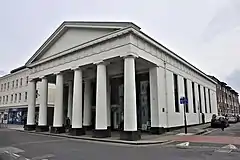Corn Exchange, Chichester
The Corn Exchange (also the Exchange Cinema and the Granada Exchange) is a Grade II* listed building[1] in Chichester, West Sussex, England. Built in 1833, the building has also been used as a Granada cinema. It is currently leased to a number of companies, including Next and the Boston Tea Party café chain.
| Corn Exchange | |
|---|---|
 The Corn Exchange, East Street, Chichester | |

| |
| General information | |
| Town or city | Chichester |
| Country | England |
| Coordinates | 50.8360°N 0.7756°W |
| Current tenants | |
| Construction started | 1833 |
| Design and construction | |
| Architect | George Draper |
History
The Corn Exchange was built between 1832 and 1833 by local architect George Draper,[2] on the corner of East Street and Baffin's Lane in Chichester.[3] In 1835 the roof was found to be unsafe and the building was stated to be in danger of collapse; architect John Elliott rebuilt and remodelled it the following year.[2][4]
The Corn Exchange was financed by 70 local corn merchants, who each contributed between £25 and £250.[2] Corn, wheat, oats and barley were commonly traded at the Corn Exchange,[2] and in 1899 wool fleeces were also recorded as being sold at auction at the Corn Exchange.[5] The Corn Exchange was set up to increase trade of goods, as local merchants were unwilling to sell small quantities of goods. They preferred to sell at least a bushel at a time.[6] The Corn Exchange also allowed merchants to sample goods before purchasing them.[5]
.jpg.webp)
From the 1880s, parts of the Corn Exchange were rented out as a cinema.[2][7] It was one of Chichester's first cinemas, and the Corn Exchange has a blue plaque commemorating this.[5] In 1922, the Corn Exchange became a full-time cinema,[8] and the following year, the cinema was purchased by London and District Cinemas.[2] In 1927, the cinema was renovated, and was renamed the Exchange Cinema. The Kid Brother was the first film shown at the renovated cinema.[8]
In 1948, Granada cinemas took over the Corn Exchange, and named it the Granada Exchange.[1][9] The Granada cinema closed in 1980. Star Wars film The Empire Strikes Back was the last film shown at the Granada cinema.[8] The Corn Exchange was then left unused for six years, before being leased to McDonald's, who used it until at least the late 1990s.[8][7]
Part of the Corn Exchange is currently leased to Next. In 2018, Next said that they were looking to close their Chichester Corn Exchange store.[10] Other companies that have been based in the Corn Exchange include the Boston Tea Party café chain,[11] a Grape Tree health food store, and two Indian restaurants.[12]
To the rear stood a three-storey corn store built of red and grey brick. This was modified and converted into offices in 1967. Another corn store designed in 1871 by architect John Elkington, this time of stone with brick dressings, was similarly converted in the early 1980s.[13]
Architecture
The building is Greek Revivalist in style.[3] Across the front of the building are six Doric columns,[3][1] each of which weigh 3 tonnes[5] and are made of cast iron.[4] They form a "noble hexastyle portico" which projects on to the pavement and rests on six substantial stone bases.[4] There are four smaller columns behind it. These support a large pediment and decorative entablature which runs around the side elevations of the building.[13]
References
- "The Granada Cinema". Historic England. Archived from the original on 7 June 2020. Retrieved 7 June 2020.
- "Chichester Corn Exchange". The Novium. Archived from the original on 7 June 2020. Retrieved 7 June 2020.
- "A History of the County of Sussex". Victoria County History. 1935. pp. 71–82. Archived from the original on 7 June 2020. Retrieved 7 June 2020 – via British History Online.
- Williamson, Elizabeth; Hudson, Tim; Musson, Jeremy; Nairn, Ian (2019). Sussex: West. The Buildings of England. New Haven and London: Yale University Press. p. 260. ISBN 978-0-300-22521-1.
- MacDougall, Phillip (2018). A–Z of Chichester: Places-People-History. Amberley Publishing Limited. Archived from the original on 7 June 2020. Retrieved 7 June 2020.
- Report from the Select Committee on Agriculture: With the Minutes of Evidence Taken Before Them and an Appendix and Index. House of Commons. 1833. p. 475. Archived from the original on 7 June 2020. Retrieved 7 June 2020.
- MacDougall, Phillip (2009). Chichester Murders & Misdemeanours. Amberley Publishing Limited. Archived from the original on 7 June 2020. Retrieved 7 June 2020.
- "Granada Chichester". Cinema Treasures. 2008. Archived from the original on 24 October 2015. Retrieved 8 June 2020.
- Green, Alan H.J. (2015). Chichester in the 1960s. The History Press. Archived from the original on 7 June 2020. Retrieved 7 June 2020.
- "Next in Chichester looking to close". Chichester Observer. 23 April 2018. Archived from the original on 7 June 2020. Retrieved 7 June 2020.
- "Latest café chain bid for Chichester provokes anger". Chichester Observer. 6 October 2016. Archived from the original on 7 June 2020. Retrieved 7 June 2020.
- "Two curry houses and a health food store aim to open in Chichester". Chichester Observer. 7 September 2017. Archived from the original on 7 June 2020. Retrieved 7 June 2020.
- Williamson, Elizabeth; Hudson, Tim; Musson, Jeremy; Nairn, Ian (2019). Sussex: West. The Buildings of England. New Haven and London: Yale University Press. p. 261. ISBN 978-0-300-22521-1.